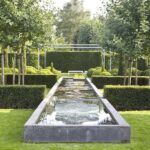Contemporary garden design is a popular trend that emphasizes clean lines, minimalism, and the integration of modern elements into outdoor spaces. This style of design focuses on creating a harmonious and functional garden that complements the surrounding architecture and landscape.
One key feature of contemporary garden design is the use of straight lines and geometric shapes. This can be seen in the layout of pathways, plant beds, and hardscape elements such as decking or paving. By using straight lines and geometric shapes, contemporary gardens achieve a sleek and organized look that is visually appealing and easy to maintain.
In addition to clean lines, contemporary garden design often incorporates a minimalist approach to planting. This means using a limited color palette, simple plant combinations, and a focus on textures and foliage rather than flowers. The goal is to create a serene and uncluttered garden that is both aesthetically pleasing and low-maintenance.
Another hallmark of contemporary garden design is the use of modern materials and features. This can include sleek metal planters, concrete or steel edging, and minimalist furniture and accessories. These modern elements help to create a sense of unity between the interior and exterior spaces, blurring the boundaries between indoors and outdoors.
Contemporary gardens also often include sustainable and eco-friendly features, such as rainwater harvesting systems, native plantings, and drought-tolerant landscaping. These elements not only help to reduce the environmental impact of the garden, but also create a more resilient and low-maintenance outdoor space.
Overall, contemporary garden design offers a fresh and innovative approach to creating outdoor spaces that are both functional and visually appealing. By embracing clean lines, minimalist planting schemes, modern materials, and sustainable features, homeowners can transform their gardens into sleek and stylish retreats that reflect the best of modern design trends.
















